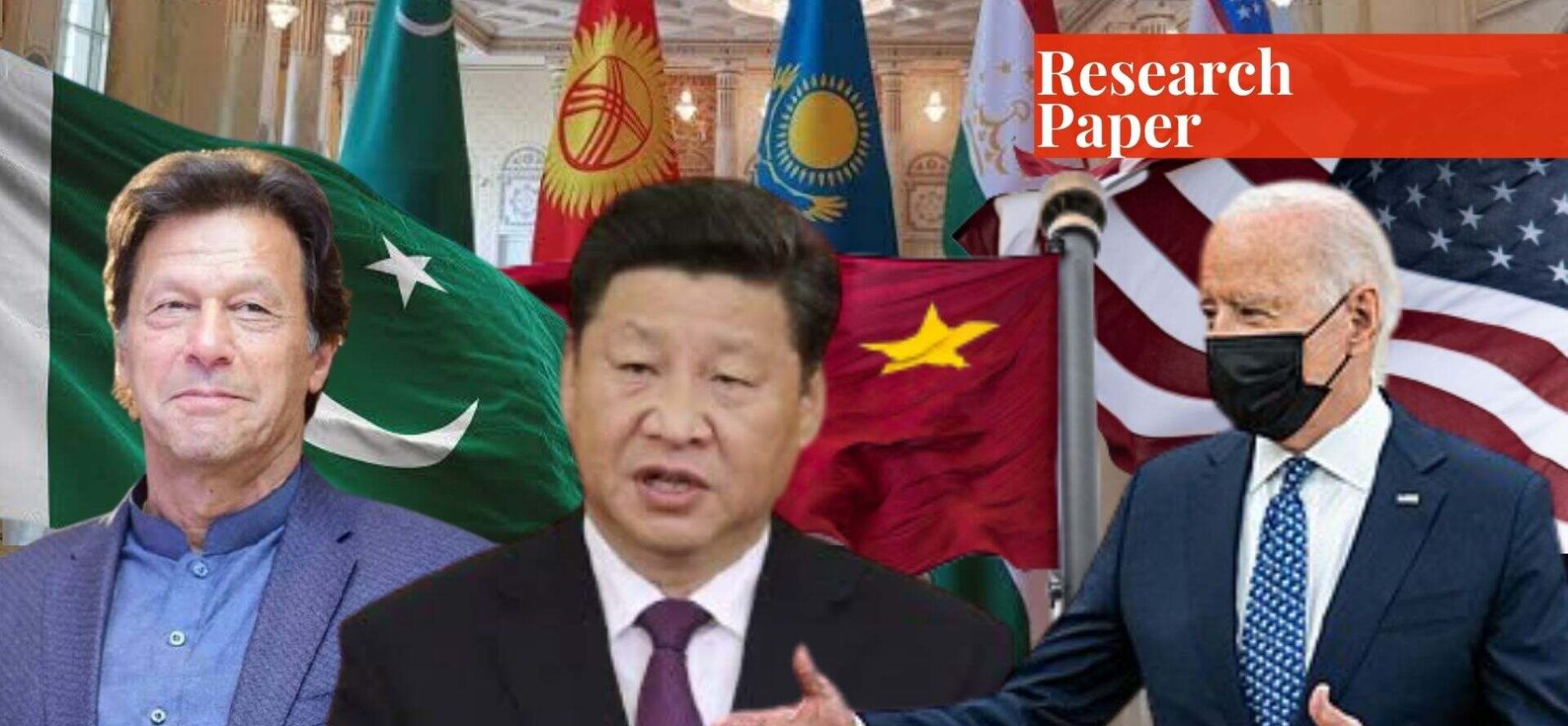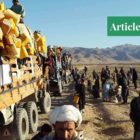Introduction
Central Asia, the descendant of the dismembered Soviet Union, has today transformed into the pivot of global geopolitics of energy. Known as the heartland of Eurasia, Central Asia serves as a vital link between a number of strong and dynamic economies, including China, the European Union, India, Japan, and Russia.
Central Asia’s significance stems from its huge reserves of untapped, clean, efficient, secure, raw, and abundant energy, mineral and metal resources; its landlocked geography; its geostrategic location and economic potential. These are the factors that intrigue regional and global powers to engage in a power struggle of enhancing their respective influence in the region.
The aim of this term paper is mainly to explore and analyse the possible motives of Pakistan, China, and the United States behind the hunt for dominance in the region, their underlying interests, and suggestions for all three contenders to enhance their influence as well as for the republics of Central Asia to keep at bay any one of these competitors from becoming a major stakeholder in the region.
Pakistan’s Course of Interests
With the changes in international political dynamics coupled with a leadership change, Pakistan has revisited its policy towards Central Asia and this shift is aroused by a number of interests.
Commercial Interests
Pakistan, the second most populated country of South Asia and the sixth most populated country in the world, faces a severe energy crisis. Pakistan produces 25,000 MW of electric supply and at the height of the season, has an electricity shortage of up to 7000 MW.1 This insufficiency has inflicted losses worth billions of dollars upon the country’s economy.
According to a report published by Marco Economic Insights, the power crisis has cost Pakistan approximately $82 billion in GDP between 2007 and 2020.2 With an estimation of a 3% population growth rate annually, Pakistan’s annual energy demands and consumption rates are accelerating manifolds.
As per an economic survey, energy sector consumption in 2011 was 38.8 MTOE (million tonnes of oil equivalent) and it has raised the bar up to 70.5 MTOE in 2016.3 In order to meet these demands, Pakistan is draining out its energy resources, with a prediction of exhaustion of oil reserves by 2025 and natural gas reserves by 20304 as well as the complete scarcity of water by 2040.5
Currently, Pakistan is mainly dependent on Saudi Arabia and other Gulf countries to fulfil its domestic energy demand, but these allegiances have time and again caused Pakistan to compromise on national interests. In this trade-off between complying with the state’s energy demands and maintaining one’s integrity and sovereignty, the republics of Central Asia can prove to be a breath of fresh air in this respect.
With the world’s second-largest energy reservoirs, Central Asia can be the solution to all the energy problems of Pakistan. The nearest, top-quality, cost-effective, and untapped billion barrels of energy reserves are the primary attraction that Central Asia holds for Pakistan.
Economic Interests
By establishing sound economic and trade relations, Pakistani goods can ensure and access the firm $90 billion Central Asian market and simultaneously, the republics of Central Asia can prove to be an economical source for Pakistan’s imports of raw materials and manufactured goods.
Pakistan also has interests in generating economic activity through mutual trade, granting access to trade routes, and improving communication routes including railway links, roads, air routes etcetera. This can alleviate distressing economic conditions in Pakistan and improve the country’s economy.
Geo-Strategic Interests
Due to its unique geographical location, Pakistan serves as a bridge between Central Asia, South Asia, Southeast Asia, and West Asia. This connectivity feature along with Central Asia’s characteristic of being landlocked serves as the driving factor in the establishment of cooperative bilateral and multilateral relationships between Pakistan and the republics of Central Asia.
The provision of the shortest transit trade route of approximately 2000 km and 2700 km from Dushanbe to Gwadar and Karachi ports via Afghanistan will be beneficial for Central Asia by reducing the distance from alternative routes by 50%, freight charges by 30%, generating economic activity, employment and tax collections.
It will also ensure improved security and strategic relations of Pakistan with the northern front, that is, Afghanistan, Russia, Iran, and the republics of Central Asia. Ensuring border security with the most vulnerable and sensitive areas of Afghanistan and Iran is Pakistan’s foremost priority that can further strengthen the region’s objective towards peace and prosperity.
Political Interests
Increasing its area of interest is one of the main political objectives and foreign policy goals of a state and by establishing extensive bilateral relations, Pakistan can become an important stakeholder in the region which further allows a state to be in a bargaining position in international affairs.
Another important reason for Pakistan to maintain a presence in Central Asia is to counter the Indian threat and influence in the region. Developing friendly relations with the republics of Central Asia and Afghanistan will provide Pakistan strategic depth against India.
Many Pakistani military analysts believe that “Pakistan is geographically a narrow country and an Indian attack can cut through the county and divide it into two halves In such a case, they believe, Afghan territory could provide a suitable “Strategic Depth” to which the Pakistan army can retreat and regroup in order to launch a counter-attack.”6 Hence, the Central Asian region holds enormous potential for cooperation and collaboration in approximately every sector; be it commercial, economic, security or political.
Despite the recognition of the prospects, Pakistan has been unable to translate and prioritise its interests in the region due to its weak and West-centred foreign policy since independence. Moreover, its active participation in the Afghan war of 1979 deteriorated its image among the republics of Central Asia.
Now, there is a change in international dynamics such as the withdrawal of NATO forces from Afghanistan, the increasing geoeconomic importance of Central Asia, and the rise of the new “Great Game” in Central Asia between Russia, the US and China.
This change in global politics has redefined our national interests and also marked a shift in policy from security and military towards geoeconomics as highlighted by the Prime Minister in Uzbekistan’s Conference of Regional Connectivity 2021, “Pakistan with a shift in its policy from geo-strategic to geo-economics wants to strengthen its trade and economic relations with the Central Asian states.”7
Therefore, this new road to partnership can be mutually beneficial and fruitful provided it proceeds with caution and vigilance.
China’s Pursuit of Power
As an emerging power, China is trying to maintain its influence in the five republics of Central Asia due to their important strategic location and rich natural resources. These republics are part of China’s Belt and Rod initiative which increases the importance of the region even more.
Trade relations between the republics of Central Asia and China continue to grow because of underdeveloped infrastructure, energy resources, politics, and security dynamics.8 After the disintegration of the USSR, the republics of Central Asia have been a priority of China due to their international security dynamics.9
Economic Interests
Central Asia is said to be an important source of energy resources required to meet the needs of the rapidly growing Chinese economy.10 The republics of Central Asia, too, seek partners as they lack mechanisms for extracting natural resources. China is one of the largest trade partners of the three republics of Central Asia.
China considers the republics “a promising market for goods”,11 which will not only benefit the purpose of regional development but also the Chinese economy. However, economic engagement with Central Asia should be governed by strict principles considering the republics’ national interests.
Political Interests
One of the reasons behind China’s involvement in Central Asia is to resolve Xinjiang Uighur Autonomous Region bordered with three Central Asian republics i.e. Kazakhstan, Kyrgyzstan, and Tajikistan.12 The Shanghai Cooperation Organisation (SCO) was one of the initiatives taken mutually by China and Russia to promote regionalism and facilitate negotiations among China, Russia, and the republics of Central Asia.
Through the SCO, China was able to succeed to build bilateral relations with the republics of Central Asia.13 Another factor compelling China’s presence in CARs is the US’s involvement and relations with Central Asia. After 9/11, security cooperation between the United States and Central Asian republics alarmed Russia and China. Hence, new regional alignments such as the SCO was formed to rescue the interest of regional players.14
Geo-Strategic Interests
An alternative route for accessing international transport corridors, thanks to its infrastructure potential, the Central Asian region could become a transportation hub for Eurasia.15 Central Asia is one of the most important regions because of its strategic location since it links Europe with Asia. The BRI is a massive project for international cooperation propelled by regional economic collaboration and development.
Security Interests
Due to the great power play in the region, the political radicalization of Islam and militant networks have escalated in Central Asia which pose threat to the region.16 Since Russia might move its military to Syria, it might trigger Daesh which was labelled a terrorist organization by the UN.
The escalation of Daesh and terrorist fighters in Afghanistan will have direct consequences for neighboring countries like Iran, Central Asian republics, China, and Pakistan.17 A number of Islamic extremists and terrorists in China’s Xinjiang Uygur Autonomous Region received training and supplies from Al-Qaeda and the Taliban in Afghanistan.
Incomplete statistics indicate that over the past three decades, “separatist, terrorist and extremist forces launched thousands of terrorist attacks in Xinjiang, killing large numbers of innocent people and hundreds of police officers, and causing immeasurable damage to property”.18
Some of the Uygur extremists and terrorists also entered Central Asian states and Russia to join local terrorist groups. China seeks to curb terrorism and extremist Islamic militant networks from the region to confront security threats in Xinjiang.
The Concerns of the United States
Since the 1990s, the United States has established relations with the Central Asian republics to pursue its primary objective in the region, that is, a steady and secure Central Asia which would be a direct bearer of United States’ policies of counterterrorism, energy security, and regional peace.
The US’s interest in the region developed after Operation Enduring Freedom in Afghanistan and after the establishment of the Northern Distribution Network (NDN), a series of commercially based logistical arrangements connecting Baltic and Caspian ports with Afghanistan via Russia, Central Asia, and the Caucasus,19 in the light of the escalating requirement for non-lethal supplies to Afghanistan after 2009, and to decrease its dependence on supply lines through Pakistan.
Reduction of the Terrorist Threat
Reducing terrorist threats is the key objective of the US in Central Asia. To increase security and military cooperation with the republics and assist the republics in developing their self-defence capabilities is the primary strategy and policy of the United States.20 After the US withdrawal from Afghanistan, dangers implying the infiltration of revolutionary groups into Central Asia or the development of such radicalism in the region are very real-time threats.
Discontinuation of Islamic movements is one of the top priorities of the US in Central Asia, as these Islamic ideological movements are a great threat to the US’s geopolitical and economic interest in the region. The United States is also concerned about the Jihad ideology in the region as Washington is engaged in a war against the Salafi and Islamic Movement of Uzbekistan (IMU) and other Central Asian Jihadi and Islamic Ideological movements like Islamic Jihad Union IJU.21
To Prevent the Emergence of Regional Powers
China’s huge investments in Central Asia and the involvement of Russia in the politics of Central Asian states are huge concerns for the United States because both of these states have the opportunity to assert power over Central Asian governments. The United States wants to encourage and promote the integration of the region to decrease Central Asia’s dependence on China and Russia as they have the potential to weaken the presence of the United States in geopolitical affairs.22
Economic Interests
In terms of economic objectives, the US has an interest in constructing a regional energy market for Central Asia that is linked to Afghanistan, South Asia, Europe, and East Asia. To date, US efforts have focused on the plan to build a natural gas pipeline from Turkmenistan to Afghanistan, Pakistan, and India (TAPI).23
The US also has eyes on the Caspian Sea which contains vast oil and gas fields. To control the pasture or fields and the export of oil and gas from Central Asia, strategic capabilities and presence in the region are needed as a means to control the oil and gas transport infrastructure.24
Regional Stability
The Fergana Valley is rife with political, economic, and social problems. Any unrest there would affect Kyrgyzstan, Tajikistan, and Uzbekistan and could be used by extremist forces to expand their foothold in the region. Russia aspires to organize regional security in Central Asia under the Collective Security Treaty Organization (CSTO) and the SCO which does not sit well with the US
Hence, Washington’s main goal is to increase security cooperation with the Central Asian states to enhance their abilities in responding to current and future challenges affecting regional stability.25 Analysing the geographical distance along with China’s towering economic presence and Russia’s strong political influence and security relations in the region, one can raise questions about how significant the US involvement can possibly be in Central Asia.
Recommendations
Republics of Central Asia
The Central Asian Republics should carefully proceed and balance their relations with China, Pakistan, and United States. The member countries should not blindly accept the trade terms with China or the United States, rather an agreement on equally constructed terms should be signed where the interests of both parties are prioritized. While negotiating with other states, the priority of the Central Asian states should be to integrate with the world outside the Asian and Russian peninsula.
The member countries should not choose to bandwagon with either of the major power blocs, rather economic and political tiers should be promoted on a win-win basis without unnecessary inclination towards either of the hegemons. The Central Asian countries should avail themselves of every opportunity with vigilance coming their way.
Pakistan
First of all, Pakistan must revive trust and rebuild its image as a non-supporter of extremist terrorist groups through discussions, dialogues and also by supporting counter-terrorism efforts led by the Central Asian republics.
Pakistan should mediate between the republics and the Taliban to eliminate misperceptions and generate economic activities. Other than the energy sector, cultural tourism and Islamic education are the fields where Pakistan and Central Asia can yield greater opportunities for cooperation.
China
China is excessively investing and dominating every sector in Central Asia which has become a matter of unease for the republics as they do not wish to slip from the Russian umbrella straight into China’s lap. Therefore, China should revisit its engagement policies in the region and should extend a balanced approach, particularly in the energy sector.
China’s perception among the local communities is not positive. Hence, China should focus on its image building by providing the locals of these republic states with opportunities to actively engage, participate and benefit from China-sponsored projects and portray itself as “more inclusive”.
United States
The United States lacks the geographic advantage enjoyed by Russia and China in Central Asia. Given these realities, America should adopt a version of offshore balancing, using its political, economic and—as needed—security tool kit to selectively act as a partner to Central Asia to help offset the geopolitical weight of the region’s immediate neighbours.
American policy toward Central Asia should be based on the premise that it is a region of convergence rather than of competitive interests. Thus, where possible and appropriate, Washington should harness Russian and Chinese presence in the region to its favour. The US should not try to impede China’s Silk Road Economic Belt, as it will prove ineffective for Washington to take an overtly competitive approach to challenge Chinese and Russian political, economic, and security engagements in the region.
The United States needs to be realistic about what it can accomplish in an environment that is inhospitable to the growth of liberal democracies. US aid programs should not emphasize the promotion of democratic practices but instead focus more on improving quality of life, especially in the areas of healthcare, education, the environment, economic transparency, and the rule of law.
Conclusion
Central Asia has proved to have enormous potential for cooperation, and that is why all three competitors would leave no stone unturned to single-handedly dominate the region. Pakistan with cultural and religious commonalities, the United States with deep security and military ties, and China with the highest level of infiltration in the region through economic expansionism, every nominee is willing and capable enough to increase their area of influence.
Central Asia’s behaviour towards these states is what shall determine the future of the region. The republics of Central Asia should, however, carefully traverse this path of flattering opportunities and not let their vulnerability to globalise and integrate transform into a trap of increased dependence and dominance for any one of the contenders.
Endnotes
- Aziz, Sheraz. “Can China Solve Pakistan’s Energy Crisis?” The Diplomat, June 12, 2019. Accessed from https://thediplomat.com/2019/06/can-china-solve-pakistans-energy-crisis/ on Dec 12,2021.
- Sherani, Sakib. “Power Sector Challenges.” DAWN, February 12, 2021. Accessed from https://www.dawn.com/news/1606884 on Dec 12,2021.
- Deyuan, Zhang. “Pakistan’s Energy Scenario: A Forecast of Commercial Energy Consumption and Supply from Different Sources through 2030.” Energy, Sustainability and Society 8, no. 1 (2018). Accessed from https://doi.org/10.1186/s13705-018-0167-y on Dec 12,2021.
- Kugelman, Michael. “Pakistan’s Energy Crisis From Conundrum to Catastrophe?” The National Bureau of Asian Research, March 13, 2013. Accessed from https://www.nbr.org/publication/pakistans-energy-crisis/ on 12 Dec,2021.
- “Water.” Student Energy Water Source. Accessed December 18, 2021. https://studentenergy.org/source/water/.
- Hakimi, Aziz. “Af-Pak: What Strategic Depth?” openDemocracy, February 4, 2010. Accessed from https://www.opendemocracy.net/en/opensecurity/af-pak-what-strategic-depth/ on 12 Dec,2021.
- APP. “Pakistan, Uzbekistan Set up Strategic Partnership.” The Express Tribune, July 15, 2021. Accessed from https://tribune.com.pk/story/2310689/pakistan-uzbekistan-set-up-strategic-partnership on 12 Dec,2021.
- Melnikovová,Lea .“China’s interests in Central Asian economies” De Gruyter, April 15, 2020. https://www.degruyter.com/document/doi/10.1515/humaff-2020-0022/html.
- Lynch,Ian J. “What Are the Implications of China’s Growing Security Role in Central Asia?” The Diplomat, June 03, 2020. https://thediplomat.com/2020/06/what-are-the-implications-of-chinas-growing-security-role-in-central-asia/.
- Melnikovová,Lea .“China’s interests in Central Asian economies” De Gruyter, April 15, 2020. https://www.degruyter.com/document/doi/10.1515/humaff-2020-0022/html/.
- Akram,Munir.“The New Great Game,” Dawn, October 6, 2016, Accessed from https://www.dawn.com/news/1264242.
- Khetran, Mir Sherbaz. “SCO Membership and Pakistan: Prospects of Relations with Central Asia.” Strategic Studies 39, no. 2 (2019): 83–95. Accessed from https://www.jstor.org/stable/48544301.
- Cooley, Great Games, Local Rules, 12.
- Melnikovová,Lea .“China’s interests in Central Asian economies” De Gruyter, April 15, 2020. Accessed from https://www.degruyter.com/document/doi/10.1515/humaff-2020-0022/html.
- Olivier Roy, The New Central Asia: Geopolitics and the Birth of Nations (New York: New York University Press, 2000), 144
- Abdul Aziz, “Terrorism in Central Asia: Different Names, Same Outcome,” Startfor, March 24, 2016. Accessed from https://www.stratfor.com/the-hub/terrorism-central-asiadifferent-names-same-outcome.
- The State Council Information Office of the People’s Republic of China, “The Fight Against Terrorism and Extremism and Human Rights Protection in Xinjiang,” http://english.scio.gov.cn/node_8010999.html
- “U.S. Presence in Central Asia: Realities and Perspectives,” U.S. Presence in Central Asia: Realities and Perspectives (Nurlan Aliyev ), accessed December 22, 2021. Accessed from https://www.cacianalyst.org/publications/analytical-articles/item/13619-us-presence-in-central-asia-realities-and-perspectives.html.
- Eugene Rumer, P., 2021. U.S. Policy Toward Central Asia 3.0. [online] Carnegie Endowment for International Peace. Available at: https://carnegieendowment.org/2016/01/25/u.s.-policy-toward-central-asia-3.0-pub-62556
- Nikkei Asia. 2021. The new Great Game: Central Asia struggles to balance three powers. [online] Available at: <https://asia.nikkei.com/Spotlight/The-Big-Story/The-new-Great-Game-Central-Asia-struggles-to-balance-three-powers> [Accessed 22 December 2021].
- Apps.dtic.mil. 2021. [online] Available at: <https://apps.dtic.mil/sti/pdfs/ADA485885.pdf> [Accessed 22 December 2021].
- Eugene Rumer, P., 2021. U.S. Policy Toward Central Asia 3.0. [online] Carnegie Endowment for International Peace. Available at: <https://carnegieendowment.org/2016/01/25/u.s.-policy-toward-central-asia-3.0-pub-62556> [Accessed 22 December 2021].
- 2021. [online] Available at: <https://www.researchgate.net/publication/349915482_Power_Interest_And_Rivalry_of_Major_Powers_United_States_Russia_And_China_In_Central_Asia/link/604719c392851c077f27e0fc/download> [Accessed 22 December 2021].
- Eugene Rumer, P., 2021. U.S. Policy Toward Central Asia 3.0. [online] Carnegie Endowment for International Peace. Available at: <https://carnegieendowment.org/2016/01/25/u.s.-policy-toward-central-asia-3.0-pub-62556> [Accessed 22 December 2021].
Bibliography
- 2021. [online] Available at: <https://www.researchgate.net/publication/349915482_Power_Interest_And_Rivalry_of_Major_Powers_United_States_Russia_And_China_In_Central_Asia/link/604719c392851c077f27e0fc/download> [Accessed 22 December 2021].
- Abdul Aziz, “Terrorism in Central Asia: Different Names, Same Outcome,” Startfor, March 24, 2016, www.stratfor.com/the-hub/terrorism-central-asiadifferent-names-same-outcome.
- Akram,Munir. “The New Great Game,” Dawn, October 6, 2016, https://www.dawn.com/news/1264242.
- APP. “Pakistan, Uzbekistan Set up Strategic Partnership.” The Express Tribune, July 15, 2021. https://tribune.com.pk/story/2310689/pakistan-uzbekistan-set-up-strategic-partnership.
- Apps.dtic.mil. 2021. [online] Available at: <https://apps.dtic.mil/sti/pdfs/ADA485885.pdf> [Accessed 22 December 2021].
- Aziz, Sheraz. “Can China Solve Pakistan’s Energy Crisis?” The Diplomat, June 12, 2019. https://thediplomat.com/2019/06/can-china-solve-pakistans-energy-crisis/.
- Cooley, Great Games, Local Rules, 12.
- Deyuan, Zhang. “Pakistan’s Energy Scenario: A Forecast of Commercial Energy Consumption and Supply from Different Sources through 2030.” Energy, Sustainability and Society 8, no. 1 (2018). https://doi.org/10.1186/s13705-018-0167-y.
- Eugene Rumer, P., 2021. U.S. Policy Toward Central Asia 3.0. [online] Carnegie Endowment for International Peace. Available at: <https://carnegieendowment.org/2016/01/25/u.s.-policy-toward-central-asia-3.0-pub-62556> [Accessed 22 December 2021].
- Hakimi, Aziz. “Af-Pak: What Strategic Depth?” openDemocracy, February 4, 2010. https://www.opendemocracy.net/en/opensecurity/af-pak-what-strategic-depth/.
- Khetran, Mir Sherbaz. “SCO Membership and Pakistan: Prospects of Relations with Central Asia.” Strategic Studies 39, no. 2 (2019): 83–95. https://www.jstor.org/stable/48544301.
- Kugelman, Michael. “Pakistan’s Energy Crisis From Conundrum to Catastrophe?” The National Bureau of Asian Research, March 13, 2013. https://www.nbr.org/publication/pakistans-energy-crisis/.
- Lynch,Ian J. “What Are the Implications of China’s Growing Security Role in Central Asia?” The Diplomat, June 03, 2020. https://thediplomat.com/2020/06/what-are-the-implications-of-chinas-growing-security-role-in-central-asia/
- Melnikovová,Lea .“China’s interests in Central Asian economies” De Gruyter, April 15, 2020. https://www.degruyter.com/document/doi/10.1515/humaff-2020-0022/html.
- Nikkei Asia. 2021. The new Great Game: Central Asia struggles to balance three powers. [online] Available at: <https://asia.nikkei.com/Spotlight/The-Big-Story/The-new-Great-Game-Central-Asia-struggles-to-balance-three-powers> [Accessed 22 December 2021].
- Olivier Roy, The New Central Asia: Geopolitics and the Birth of Nations (New York: New York University Press, 2000), 144.
- Sherani, Sakib. “Power Sector Challenges.” DAWN, February 12, 2021. https://www.dawn.com/news/1606884.
- The State Council Information Office of the People’s Republic of China, “The Fight Against Terrorism and Extremism and Human Rights Protection in Xinjiang,” http://english.scio.gov.cn/node_8010999.html
- “U.S. Presence in Central Asia: Realities and Perspectives,” U.S. Presence in Central Asia: Realities and Perspectives (Nurlan Aliyev ), accessed December 22, 2021. Accessed from https://www.cacianalyst.org/publications/analytical-articles/item/13619-us-presence-in-central-asia-realities-and-perspectives.html.
- “Water.” Student Energy Water Source. Accessed December 18, 2021. https://studentenergy.org/source/water/.
If you want to submit your articles, research papers, and book reviews, please check the Submissions page.
The views and opinions expressed in this article/paper are the author’s own and do not necessarily reflect the editorial position of Paradigm Shift.





















